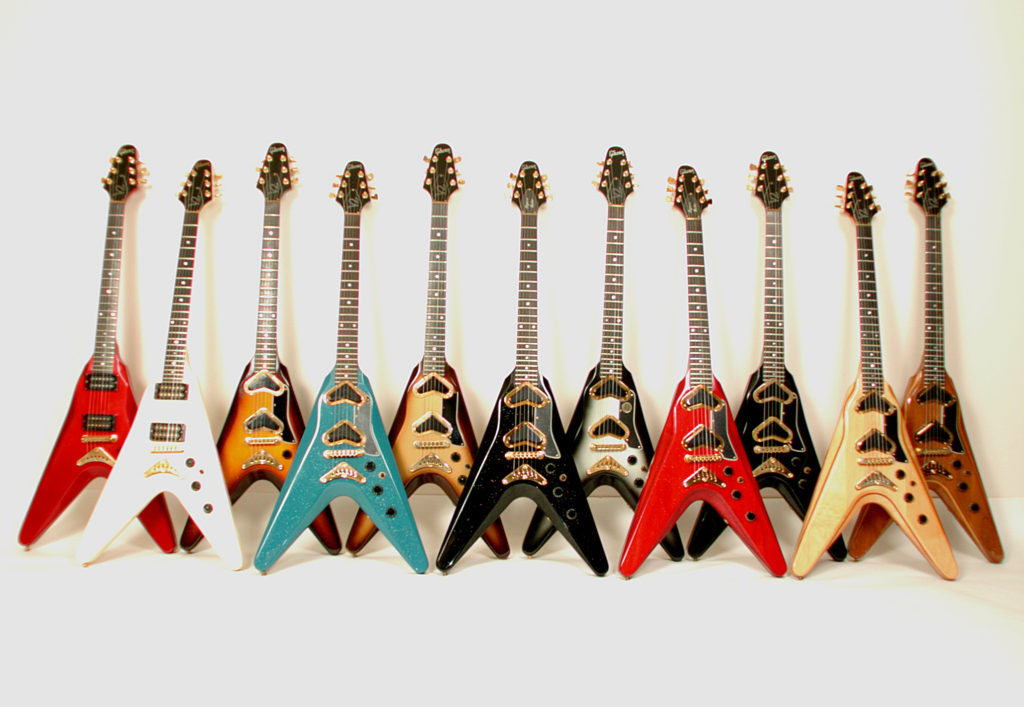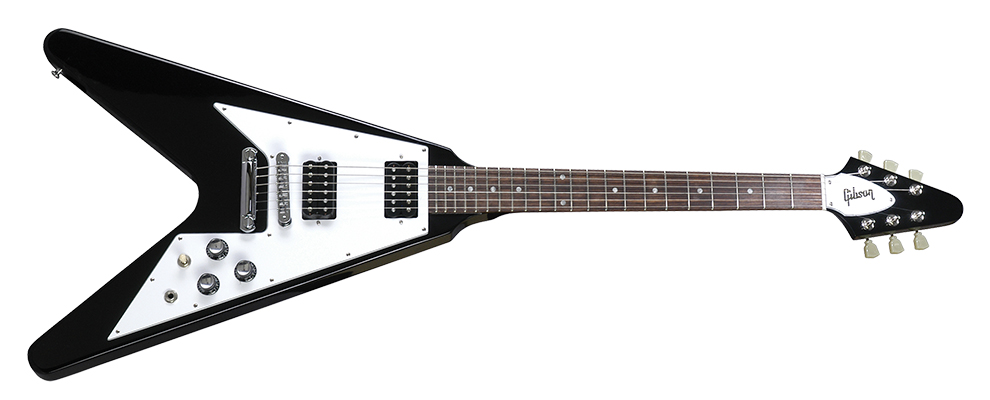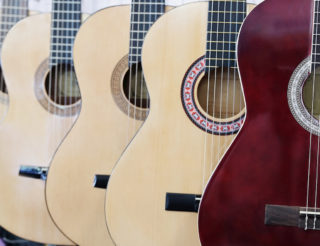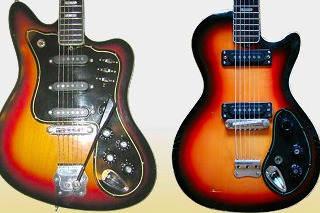10 Guitars You Need to Know #4: The Flying V
Author: Lucas Frost

Table of Contents
Form over Function? The Flying V
There are typically four key factors that go into choosing a guitar:
- Tone
- Playability
- Quality of Craftsmanship
- Aesthetics
Surely what matters most to us guitarists is tone: pickups, tonewoods and body type. And playability (stuff like fretboard radius or string spacing) and quality of craftsmanship (how many times can I whack the floor before the guitar breaks? Apparently Pete Townsend preferred Fender’s durability in this scenario).
Ted McCarty was looking to cement the Gibson brand as an industry leader with an avant-garde aesthetic
But what about the visual element, the style and looks? How important are aesthetics for guitarists? In the mid-Fifties, Gibson’s president Ted McCarty noticed that his company’s traditional image was out of step with post-war youth culture. Fender had just released the Stratocaster, and McCarty was looking for a guitar with a more avant-garde aesthetic, a statement to cement the Gibson brand as an industry leader. McCarty commissioned several artists to sketch energetic guitar designs, of which the best were selected for the prototype stage. In the end, only two models ended up in Gibson’s new “futuristic” series, released in 1958: the Explorer and the Flying V.

The Flying V is unmistakable, with its arrow headstock and bold, v-shaped body.
What else distinguishes it, apart from shape? The original was made of Korina, an exotic wood with warmth, definition, clarity and sustain – in many ways similar to Mahogany, but a little brighter in sound and colour. It weighed less too, while its pale blonde made it more relevant to the positivity of pop-culture in the 1950s. Arguably the perfect tonewood, Korina (also known as Limba) had never been used in guitars before and certainly generated the desired hype among trade-shows. And it sounded great, the meticulous craftsmanship typical of Gibson resulting in a sweet tone and fine playability.
And it sounded great, the meticulous craftsmanship typical of Gibson resulting in a sweet tone and fine playability.
But alas, Flying Vs did not sell
They were expensive, owing largely to the precious Korina wood, which is difficult to get hold of and difficult to work with. And the guitar’s balance was awful, hanging low on the neck side. Most people didn’t know what to think of it – many dealers bought only one guitar to use as a display item in their shop, to create a stir and attract customers. Basically the first Flying Vs were used as guitar-mannequins. Others found it too outlandish and weird, and didn’t make any orders. As a result, only around 80 guitars shipped in the first year, and production was phased out the following year. For Gibson, the Flying V was a massive commercial flop. Nobody seemed to like the new futuristic style… Basically the first Flying Vs were used as guitar-mannequins. Slowly, the few guitars that were in circulation started being noticed.
 But very slowly, the few guitars that were in circulation started being noticed, thanks largely to the unusual aesthetic. Blues legend Albert King, who played left-handed, appreciated the V’s symmetry – it suited his unusual style of playing guitars strung the standard right-handed way and simply flipping it over. Then there was Dave Davies. While invading America with The Kinks in 1965, he lost his guitar on the journey across the Atlantic. Struggling to find a guitar that he liked in a local US music shop, the shop-owner finally pulled one of the original, neglected Flying Vs out of the broom cupboard, which Davies bought for $60. The guitar appeared on the cover of The Kinks’ chart-topping album the following year, giving the V much appreciated exposure.
But very slowly, the few guitars that were in circulation started being noticed, thanks largely to the unusual aesthetic. Blues legend Albert King, who played left-handed, appreciated the V’s symmetry – it suited his unusual style of playing guitars strung the standard right-handed way and simply flipping it over. Then there was Dave Davies. While invading America with The Kinks in 1965, he lost his guitar on the journey across the Atlantic. Struggling to find a guitar that he liked in a local US music shop, the shop-owner finally pulled one of the original, neglected Flying Vs out of the broom cupboard, which Davies bought for $60. The guitar appeared on the cover of The Kinks’ chart-topping album the following year, giving the V much appreciated exposure.
Riding on this wave of popularity, Gibson reissued the Flying V in 1967, almost a decade after it first appeared. The new Vs came with some small alterations, such as a (cheaper) mahogany body and a larger pickguard. Gibson was in luck: when hard rock hit in the 70s, the Flying V’s bold, assertive and rebellious image had found the perfect partner. Not only did it sound powerful and distorted easily in typical Gibson fashion, but it also looked assertive and outlandish. As Rock grew into Metal over the years, the Flying V became cemented in popular conscience as the symbol of teenage rebellion, the badge of Metal in all its visceral power and frantic energy. Luckily McCarty had patented his designs, so presumably Gibson gets money for all the pointier V derivatives offered by the likes of Dean, Jackson or ESP.
Clearly there are many ways in which the slab of wood that forms the guitar body can be shaped and designed. However, the guitar’s form can only be altered so much before its “function” will be compromised. The Flying V and Explorer models look distinctive and different (and sound excellent!), but many guitarists find them uncomfortable and cumbersome to play. Such guitars stand by themselves and refuse to bend to a human body-shape. There are many other examples: B.C. Rich, who specialize in guitars with fantastical designs, have a range made of acrylic – translucent, with exposed electronics and cool light-bending properties. The B.C. Rich Acrylic Mockingbird may kill with its looks under the spotlight, but the heavier acrylic would tire most people put after an hour on stage. Guitars have been made in the shape of women, motorcycles, guns and penises – even ZZ Top’s fluffy sheepskin Explorers look tame in comparison.
Guitars in many shapes & Textures…
Style vs function… what matters more? In the end, function and form need to work together – musicians want to find congruence between their visual and sonic expression, a guitar that embodies their musical creativity in sound as well as looks. Live performances often produce the more primal, emotional impact – so here the visual message that the guitarist (and his guitar) send are worth tons. So whatever you may think of the Flying V and other modernist guitars, they hold a very important position within the guitar pantheon. Today, the original Flying Vs from 1958 are among the most precious guitars in the world, fetching sums in excess of $300,000 – enough proof that in many cases, style does trump function.
The original Flying Vs from 1958 are among the most precious guitars in the world, fetching sums in excess of $300,000 – enough proof that in many cases, style does trump function.
Did you enjoy this history lesson of the sound of the flying v guitar? If you did, we have several other articles on our site that you can browse and enjoy. Some of our most recent articles include a guitar with app to teach kids, songs with b minor to g chord progressions, as well as the types of effects used by popular guitarists.








No comments yet - be the first.